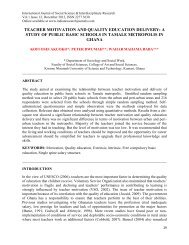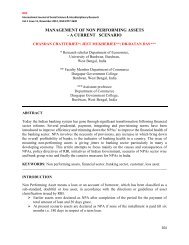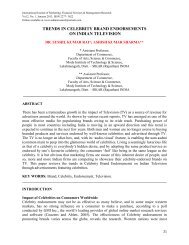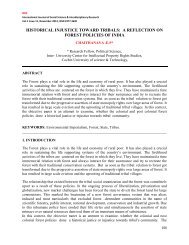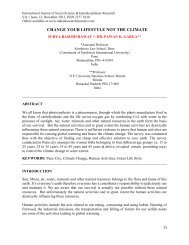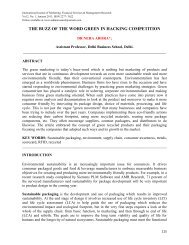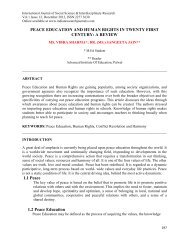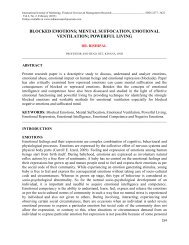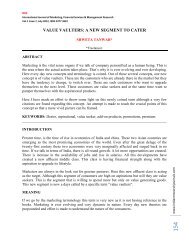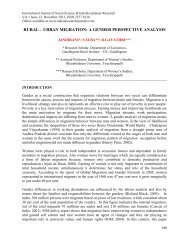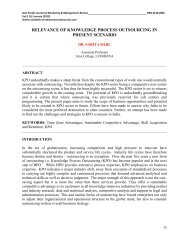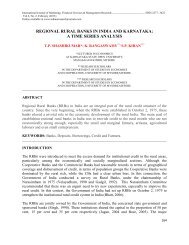application of remote sensing and gis for flood risk analysis: a case ...
application of remote sensing and gis for flood risk analysis: a case ...
application of remote sensing and gis for flood risk analysis: a case ...
Create successful ePaper yourself
Turn your PDF publications into a flip-book with our unique Google optimized e-Paper software.
IRJC<br />
International Journal <strong>of</strong> Social Science & Interdisciplinary Research<br />
Vol.1 Issue 11, November 2012, ISSN 2277 3630<br />
A study <strong>of</strong> various types <strong>of</strong> <strong>flood</strong> <strong>and</strong> their characteristics in general will be required to<br />
underst<strong>and</strong> the characteristics <strong>of</strong> <strong>flood</strong> in the villages <strong>of</strong> Raichur district under Krishna <strong>and</strong><br />
Tungabhadra river valley region. This study will be carried out from secondary sources.<br />
However primary survey will be conducted<br />
1. To study the characteristics, causes <strong>and</strong> impact <strong>of</strong> <strong>flood</strong> affected villages in the study area<br />
2. To study the efficacy <strong>of</strong> existing Post <strong>flood</strong> rural planning <strong>and</strong> development strategies<br />
<strong>for</strong> the <strong>flood</strong> affected villages in the study area.<br />
As the government has intervened in the planning <strong>and</strong> development processes in the <strong>flood</strong><br />
affected regions some secondary in<strong>for</strong>mation will also be available, the same will be used to<br />
underst<strong>and</strong> the characteristics, causes <strong>and</strong> impact <strong>of</strong> <strong>flood</strong>. Based on the research study effective<br />
Post <strong>flood</strong> rural planning <strong>and</strong> development strategies will be proposed <strong>for</strong> the type <strong>of</strong> <strong>flood</strong><br />
which generally prevailed in the study area.<br />
To underst<strong>and</strong> the causes <strong>for</strong> <strong>flood</strong> in the villages a detailed study will be carried out on the <strong>flood</strong><br />
phenomena in the study area by referring to its past recorded in<strong>for</strong>mation. Also a field survey<br />
(general enquiries <strong>and</strong> observation) will be conducted to study effects <strong>of</strong> <strong>flood</strong> on the village<br />
settlements. The effect <strong>of</strong> <strong>flood</strong> has been studied categorically in terms <strong>of</strong> its implications on<br />
social, economic <strong>and</strong> physical structure <strong>of</strong> villages.<br />
A set <strong>of</strong> data will be collected regarding the planning measures that have been undertaken during<br />
the <strong>flood</strong> <strong>and</strong> on the post effects <strong>of</strong> <strong>flood</strong>. Based on the data <strong>analysis</strong> <strong>and</strong> literature <strong>case</strong> studies,<br />
some planning suggestions were proposed <strong>for</strong> the effective rehabilitation processes <strong>of</strong> a <strong>flood</strong><br />
affected villages.<br />
The study will be carried out by collecting data, from both primary <strong>and</strong> secondary sources:<br />
‣ Detailed mapping <strong>of</strong> the settlement pattern <strong>and</strong> topographic features <strong>for</strong> delineating the<br />
study area.<br />
‣ Hydrology <strong>and</strong> geological in<strong>for</strong>mation to identify the <strong>flood</strong> zones, major drainage system<br />
<strong>of</strong> the region <strong>and</strong> other aspects related to select the proposed area <strong>for</strong> rehabilitation.<br />
‣ Causes <strong>of</strong> the <strong>flood</strong> <strong>and</strong> their effects on socio-economic <strong>and</strong> physical structure <strong>of</strong> the<br />
village.<br />
‣ Data that can support identification <strong>of</strong> problems in the planning measures under taken by<br />
the concerned authorities <strong>and</strong> their efficacy in attaining the requirements <strong>of</strong> the <strong>flood</strong><br />
victims.<br />
Three Methods <strong>of</strong> GIS Linkage<br />
According to a literature review <strong>of</strong> GIS <strong>application</strong>s in computer modeling conducted by Heaney<br />
et al. (1999) <strong>for</strong> the U.S. Environmental Protection Agency (EPA), Shamsi (1998, 1999) <strong>of</strong>fers a<br />
useful taxonomy to define the different ways a GIS can be linked to computer models. The three<br />
methods <strong>of</strong> GIS linkage defined by Shamsi (2001) illustrated in Figure 2 are:<br />
58



